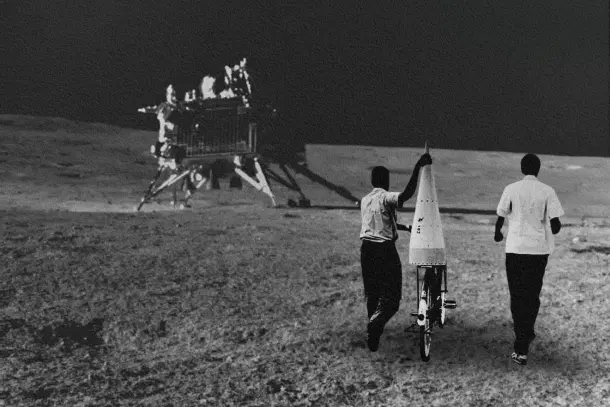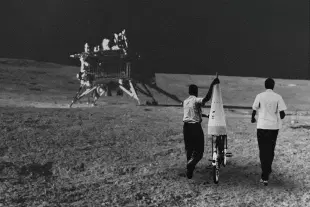Science
India's Space Journey: From Bicycle To Moon And Mars Rover To Space Station
Steve Rajpurohit
Aug 23, 2025, 07:30 AM | Updated 12:07 PM IST
Save & read from anywhere!
Bookmark stories for easy access on any device or the Swarajya app.


On a humid November day in 1963, in the coastal town of Thumba, Kerala, an unusual sight was seen. On the back of a humble bicycle was India's first sounding rocket. That rocket, a modest piece of engineering, was launched into the skies on 21 November 1963, marking the first step of a journey that would one day place India among the world's foremost space powers.
At the heart of that audacious leap stood Dr Vikram Sarabhai, widely regarded as the father of India's space programme, who believed space was not a matter of prestige but of progress. His vision was radical for its time. India would not chase superpowers in flag-planting missions but would harness space technology to solve problems of poverty, education, agriculture, and communication.
In Dr Sarabhai's words: "We must be second to none in the application of advanced technologies to the real problems of man and society." The bicycle at Thumba, therefore, was not just carrying a rocket. It was carrying the aspirations of a newly independent nation determined to lift itself to the stars.
Through the following decades, India's space programme matured step by step, each achievement becoming a foundation for the next.
In 1975, Aryabhata, India's first satellite, was launched into orbit, announcing the country's arrival in the community of spacefaring nations.
On 18 July 1980, India's first indigenous launch vehicle, the SLV-3, successfully placed the Rohini satellite RS-1 into orbit under the leadership of Dr A. P. J. Abdul Kalam.
The INSAT series, beginning in 1982, revolutionised India's broadcasting, telecommunications, meteorology, and disaster warning capabilities.
The IRS (Indian Remote Sensing) satellites, first launched in 1988, eventually created one of the world's largest constellations of civilian remote-sensing satellites.
Then came the PSLV (Polar Satellite Launch Vehicle), which became ISRO's most reliable "workhorse" rocket, known for its consistency and ability to launch multiple satellites in one mission. With it, India began launching payloads not only for itself but also for international clients, earning global recognition for affordability and reliability.
As the nation entered the 21st century, new horizons opened. Chandrayaan-1 in 2008, India's first lunar mission, made the groundbreaking discovery of water molecules on the Moon's surface.
Just five years later, the Mars Orbiter Mission (Mangalyaan) achieved the near impossible. On 5 November 2013, India launched its first interplanetary mission and became the third nation, and the first Asian nation, to reach Mars orbit. It also became the first country in the world to succeed in its maiden attempt. Remarkably, ISRO achieved this at a cost of only $74 million, less than the budget of the Hollywood film Gravity.
Opening the sector to private players
Yet for all its achievements, the system had one fundamental limitation. It was almost entirely state-run. Private players were confined to the role of suppliers, denied the chance to innovate independently. Unlike the United States, where partnerships between NASA and SpaceX transformed the landscape, India's space economy remained cautious and underdeveloped. That model was reimagined after 2014.
When Prime Minister Narendra Modi took office, his government introduced policy measures to expand the role of private players in advancing India's space sector. His remarks to ISRO scientists after the Chandrayaan-2 setback in 2019, and later after the Chandrayaan-3 success in 2023, reflected the emphasis placed on science and technology as drivers of national progress.
A set of impactful reforms reshaped India's space ecosystem:
The creation of IN-SPACe (Indian National Space Promotion and Authorisation Centre) in June 2020 became a turning point, providing a single-window mechanism for private sector participation.
The government liberalised foreign direct investment (FDI) in space, allowing 74 per cent automatic FDI in satellite manufacturing and operations, and 100 per cent in components.
The establishment of NewSpace India Limited (NSIL) in 2019 as ISRO's commercial arm enabled the monetisation of technologies.
The Union Budget 2024 set up a ₹1,000 crore venture capital fund dedicated to the space economy. From a single start-up in 2014, India had 189 space-tech firms by 2023, developing rockets, satellites, propulsion systems, and even astronaut meals.
The impact of these reforms has been profound. On 18 November 2022, Hyderabad-based Skyroot Aerospace launched Vikram-S, the first privately built rocket from Indian soil. In 2023, Chennai-based Agnikul Cosmos tested the world's first rocket engine built entirely through 3D printing. Start-ups such as Pixxel (hyperspectral imaging satellites) and Dhruva Space (small-satellite platforms) have attracted global clients.
Since 2014, India has launched around 400 foreign satellites, including payloads for 34 countries by March 2025. One notable example of ISRO's collaboration with a private firm is its partnership with Space Kidz India, a Chennai-based aerospace start-up. In 2022, ISRO launched AzaadiSAT, developed by 750 schoolgirls from rural India under the guidance of Space Kidz India.
Meanwhile, ISRO has achieved unprecedented milestones. On 23 August 2023, Chandrayaan-3 etched India's name in history by making a soft landing on the Moon's south pole, the first country ever to achieve this feat. That moment, when the Vikram lander touched down at Shiv Shakti Point, became a collective celebration across the country. It is this very success that India today celebrates as National Space Day.
Within the same year, India also launched Aditya-L1, its first dedicated solar observatory. Astrosat, launched in 2015, remains India's first multi-wavelength space observatory. Preparations for Gaganyaan, India's human spaceflight programme, are underway, with human-rated rockets tested and astronauts training in Bengaluru and Russia.
This era is also personified by people like Group Captain Shubhanshu Shukla, who in June 2025 flew aboard Axiom Mission 4 to the International Space Station, the first Indian in space in 41 years.
During 18 days in orbit, he conducted at least seven experiments, including biological and materials research, and carried cultural tokens such as freeze-dried aam ras and gajar halwa. His return, welcomed with honours by the Prime Minister, underscored India's new confidence in global space enterprise.
The achievements are not merely technological but also strategic and economic. Satellites today provide the armed forces with real-time intelligence, demonstrated during Operation Sindoor in May 2025, when ISRO satellites provided continuous surveillance that enabled precision strikes.
India's space economy is projected to grow from $8.4 billion in 2022 to $44 billion by 2033, according to a FICCI-EY report. The sector is now a major engine of growth, adding 22,000 direct jobs through private start-ups.
States such as Gujarat, Tamil Nadu, Karnataka, and Maharashtra are competing to host advanced space parks by rolling out enabling policies and offering strong investment incentives. Satellites now aid farmers in crop monitoring, fishermen in navigation, and disaster managers in cyclone warnings.
And yet, for all the triumphs already secured, the future promises even greater ambitions. The coming years will witness Gaganyaan, India's first human space mission, which will place Indian astronauts in orbit aboard an Indian rocket. Plans are underway for Chandrayaan-4, a potential lunar sample-return mission. By 2035, India plans to establish its own space station. Ambitious missions to Venus and follow-up missions to Mars are also in development.
As India celebrates National Space Day, the message is clear. This is not just about rockets and satellites, but about destiny and determination. From the bicycle at Thumba to the rover at Shiv Shakti Point, from Aryabhata to Gaganyaan, and from monopoly to competitive marketplace, India's space journey is the saga of a civilisation that has always looked up at the skies and dared to imagine.
Steve Rajpurohit posts on X at @SteveRajpurohit.





